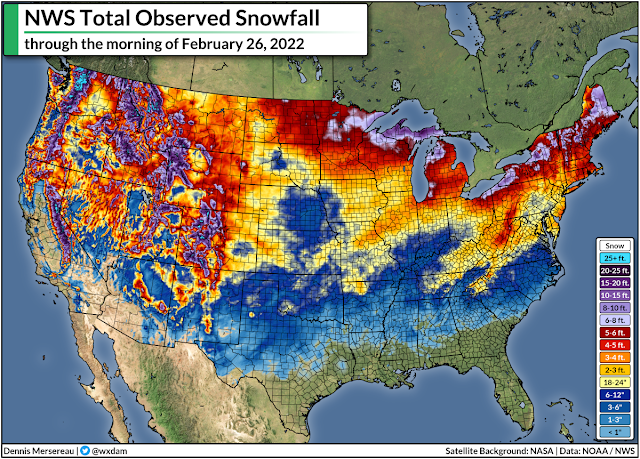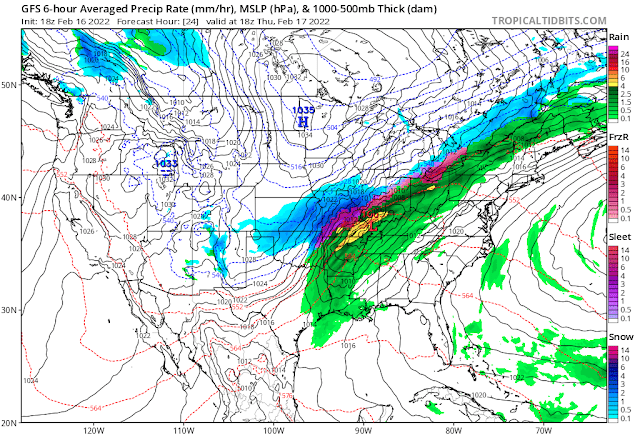The agency plans to launch GOES-T into orbit from Cape Canaveral, Florida, during the late afternoon hours on March 1st. The launch window opens at 4:38 p.m. Eastern Time, according to NOAA's countdown clock.
GOES-T will be the 18th satellite in the Geostationary Operational Environmental Satellites (GOES) family of weather satellites that began in 1975. GOES-18, as it'll be named once it goes operational later this year, is the third satellite in the fifth generation of GOES spacecraft that began with the launch of GOES-16 in 2016.
The fifth generation of GOES satellites relays breathtaking views of Earth with a resolution and timeliness that previous generations could only dream of providing. GOES-16, -17, and -18 have such fine resolution that you can see the barber's pole rotation of supercell updrafts churning over the Plains.
These satellites give us a full-disk view of the hemisphere every 15 minutes, an updated image of the continental United States every 5 minutes, and mesoscale images of small-scale areas every 30 to 60 seconds.
GOES-16, also known as GOES-East, has covered the Atlantic Ocean and eastern portions of North America and South America since early 2017.
GOES-17, launched on March 1, 2018, is known as GOES-West, covering the Pacific Ocean and western portion of the two continents. GOES-17 has also been a headache ever since it launched four years ago.
Scientists knew that GOES-17 suffered a major problem not long after launch.
We get our traditional satellite images from a device on the spacecraft known as the Advanced Baseline Imager (ABI). The ABI detects visible and infrared light radiation emitted from Earth and translates that data into the satellite images we know and love.
The different wavelengths correspond to different products we see—shorter wavelengths provide us the visible images astronauts would see looking out the window, while longer wavelengths are used for products like infrared and water vapor imagery.
 |
| An example of interference in infrared satellite imagery caused by excess heat given off by the ABI. | NOAA |
The ABI gets quite hot during normal operation, especially at night when the sun is shining directly on the Earth-facing instrument itself. The instrument relies on a cooling system to prevent it from overheating. A clog in one of the cooling pipes hampered the system's ability to cool the ABI properly, causing it to overheat during times of the day and year when the instrument faced hot sunshine.
Not only is overheating bad for the instrument, but the radiation from the heat can actually interfere with and reduce the quality of the data it collects and the images we see. An example of the interference is shown above.
Scientists spent months devising a workaround for this cooling issue. They managed to bring the spacecraft up to near-normal capacity, but there are still certain times of the day and year where the sensor gets quite toasty and image quality is degraded.
On top of those issues, the satellite has faced a couple of glitches and hiccups over the last few years, each of which caused the ABI to unexpectedly shut down for a short period of time.
GOES-17 has had a rough go of it, to say the least. Luckily, GOES-18 is on the way to give it a much-needed rest. NOAA will position the device to take over as the new GOES-West satellite, moving GOES-17 to a parking orbit as a backup in case it needs to stand in for one of the two operational satellites.
We should start seeing our first experimental, non-operational images from GOES-18 in a couple of months.
[Satellite Image: NOAA]
You can follow me on Twitter or send me an email.
Please consider subscribing to my Patreon. Your support helps me write engaging, hype-free weather coverage—no fretting over ad revenue, no chasing viral clicks. Just the weather.
Please consider subscribing to my Patreon. Your support helps me write engaging, hype-free weather coverage—no fretting over ad revenue, no chasing viral clicks. Just the weather.















